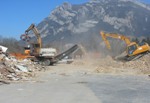Optimised management of waste, water and energy flows

Control of the environmental impacts associated with human activities is now a major issue. The explosion of energy consumption which is contributing very substantially to climate change, the massive production of waste and correspondingly weak development of secondary material recovery are at the centre of concern. The territorial authorities, called on to direct their policy at optimised waste, water and energy management, are expressing an urgent demand for decision-making aid tools.
"Integrated assessment of urban systems" is the title given to a CSTB transverse research programme initiated in 2008. "Its objective is to contribute assistance in directing public policy encouraging the global reduction of impacts associated with raw material and secondary raw material flows", is how Emmanuel Jayr, in charge of research actions and environmental engineer with the CSTB, puts it.
Adequation with resource requirements
The research work commenced in 2008 is concentrated on three vectors: waste, energy and water. Current work on the waste segment relates to general methodology for the analysis of material flows (or MFA : material flows analysis) : recycling needs, possible recovery, constraints governing material flows, energy and environmental balance, etc. The decision-making aid tool thus developed can also be applied to two studies, concerning Greater Lyon for municipal waste, and the Rhône department for construction and demolition waste and resource requirements in the building and public works sector respectively.
One of the other objectives of the programme is to adopt a method for calculating the contribution of buildings to energy consumption in a given area. The commune of Cergy Pontoise, an experimental case, has put forward an extremely precise request to determine and reduce its current carbon footprint (zero state). For this purpose, a detailed balance will be prepared on an individual building scale, to identify the origin of greenhouse gas emission and establish a plan of action. Initial work on quantification and allocation of energy consumption by item has been based on national statistical data, and an estimate of requirements in the residential sector. "The difficulty in addressing a change of space scale, from individual building to conurbation, is encouraging us to develop appropriate methods", is the view expressed by Jean-Marie Alessandrini, energy engineer with the CSTB.
Finally, for the water vector, type situations are useful for quantifying water flows at district level (individual housing estate, industrial and commercial zone and historical centre) and at city level (urban spread, degree of impermeability and growth rate) have been identified. Following this inventory phase, water consumption and discharge flows will be analysed to estimate the potential for reducing consumption according to the technical solutions which could be implemented. The decision-making aid tool for optimised water management could be established as from 2010.
"Ultimately, the CSTB will propose a decision-making aid tool to local authorities, which will enable them to direct their flow management policy in adequation with resource requirements", concluded Emmanuel Jayr.
